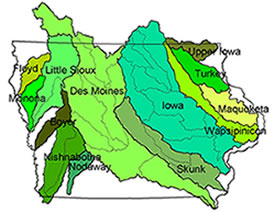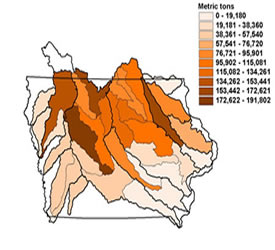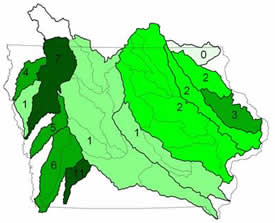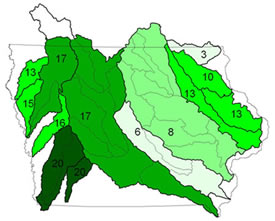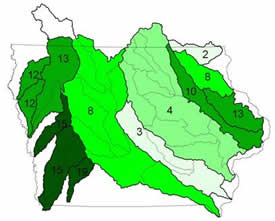|
With the specter of a new farm bill on the horizon, considerable discussion is occurring concerning the possible redirection of conservation programming and financing. Notably, interest in the increased use of incentive systems and market-like instruments continues to expand. One source of this interest lies in the desire to shift some of the burden of providing ecosystem services, such as protecting stream and river channels from erosion, maintaining biodiversity, and providing clean water and air, to private sector pockets. For example, in the fall of 2006, USDA and EPA announced a joint partnership to support expanded water quality credit trading for nutrients in the Chesapeake Bay watershed, allowing farmers to receive compensation for water quality improvements. Carbon markets, such as the active program in the European Union, are also being discussed as a possible model for expanded market-like programs in agricultural conservation policy.
While the potential cost effectiveness of providing environmental goods from incentive-based methods appears to be broadly understood, there is an additional attribute that is less broadly acknowledged: due to numerous inter-linkages in natural ecosystems, the development of a market that provides one ecosystem service may significantly change the level of provision of other ecosystem services. Thus, by developing the institutional structure to support and encourage the provision of one ecosystem service, changes, either positive or negative, in other services may result.
The example we consider here is the case in which a carbon market that would allow U.S. farmers to receive payment for sequestering carbon when they retire land from production is implemented. This could occur if the United States were to unilaterally implement such a market, or if at some future time the United States chose to sign on to a Kyoto-like accord, where carbon sinks were allowed to generate credits that could be traded to meet mandatory carbon reduction requirements. Under such a scenario, land retirement decisions would be driven by the prices paid for carbon and the amount of carbon that a particular parcel could sequester (we abstract from the important question of measuring the carbon storage potential of each parcel ― see the excellent work of Mooney et al., 2004).
Removing a parcel of land from production will change the suite of environmental benefits associated with the parcel. In many cases, these effects are likely to be positive ― for example, taking land out of active agricultural production and placing it in perennial cover or forested lands will usually yield reduced erosion and nutrient runoff relative to row crop agriculture. Indeed, the findings of our study are consistent with this outcome. However, if conservation practices are already in place on a working land field, water quality improvements from retiring the land might be small and, in fact, could be negative. The latter could occur if land retirement results in the planting of land cover that, on the whole, is not as effective in capturing nutrients and sediments as a working land system that already has effective conservation practices and management in place.
In this paper, we consider the possible water quality consequences of a carbon trading policy that allows farmers to receive carbon credits from retiring their land from agricultural production. To do so, we make a number of simplifying assumptions about the structure of the carbon market and the choices farmers make in response to the existence of that market; many of these assumptions may not, in fact, represent how an actual market might be implemented. Rather than view the results of this analysis as definitive, we present the findings in the spirit of raising awareness of the potential environmental consequences that can occur when a single environmental benefit or target (carbon sequestration) forms the basis of environmental policy, as would be the case if carbon trading markets that allowed land retirement to yield carbon credits were functioning with high carbon prices.
A Bit about Our Data and Models
To develop our models, we draw heavily from the National Resource Inventory to provide data on the land use, cropping history, and farming practices in the state of Iowa. This inventory is the most comprehensive data set on land use in the United States, and we use data on the 14,472 physical points in Iowa that represent cropland. Conceptually, our data and models are based on individual producer and farm-level behavior, and we treat an NRI point as a producer with a farm size equal to the number of acres represented by the point (the expansion factor provided by the survey). Figure 1 illustrates the 35 watersheds corresponding to the United States Geological Survey 8-digit Hydrologic Cataloging Units that are largely contained in the state and are modeled in this study. To compute the amount of carbon sequestered when a land unit is retired from cropland, we rely on estimates from the Environmental Policy Integrated Climate Model version 3060. When land is retired from crop production, we assume that annual grasses are planted and maintained on the land, and we run a 30-year simulation to predict the carbon sequestration level associated with this change.
In addition, we also rely on estimates from a watershed-based model to assess the conservation policies. Unlike carbon sequestration, the degree to which land retirement improves in-stream water quality depends on critical interactions between land uses in different locations within a watershed. Thus, for otherwise identical tracts of land, more water quality improvement may occur from retiring a piece of land from production that is located downstream from numerous other cropped points relative to one that is not. The potential filtering effect is just one example of the physical processes that need to be captured to assess the in-stream water quality effects of land retirement.
So that we can capture these land use interactions within a watershed setting, we employ the Soil and Water Assessment Tool, a biophysical water quality model, to estimate changes in nitrogen, phosphorous, and sediment loads from retiring a particular set of parcels from production within a watershed. To estimate the in-stream water quality consequences of the increase in land set aside, we have calibrated the water quality model for each of the watersheds identified in Figure 1 to baseline levels (Jha et al., 2005; Gassman et al., 2005). By running the model at the set-aside levels "after" the policy, we can compute the changes in water quality attributable to the increase in land set-aside. The watersheds studied correspond to 13 outlets, at which the in-stream water quality is measured. The water quality measures of interest are sediment, nitrogen, and phosphorus.
Water Quality Effects of a Carbon Market
To demonstrate the possible consequences of a carbon market that pays farmers for the sequestration of carbon in agricultural soils on water quality, we consider a simple scenario. Suppose that through an active carbon market, the price of carbon is such that about 10% of Iowa cropland is retired; suppose further that the cost of retiring all land within the state is about the same. While rental rates for farmland do vary across the state, they vary relatively little with respect to productivity (see Secchi & Babcock, forthcoming), and this simplifying assumption allows us to focus on environmental outcomes of the scenario without overly complicating the analysis. Under these assumptions, the cropland that will be removed from production will be the land that produces the highest carbon sequestration benefits per acre as this land will earn the highest return from carbon sequestration credits. In consequence, the land removed from production may or may not represent significant portions of the watersheds under consideration.
Based on this scenario, the land retired would be focused in the central part of Iowa, in the ecoregion known as the Des Moines Lobe, a flat area, with very productive agriculture and particularly suited for carbon sequestration. Figure 2 illustrates the quantity and location of the carbon that the carbon simulation model predicts would be sequestered across the state under this scenario. Approximately 2 million acres of land is removed from production under this scenario with about 2.7 million tons of carbon being sequestered annually.
Does this land retirement, induced by a private market that pays for ecosystem services, yield other environmental benefits to the region? To answer this question, we estimate the in-stream water quality effects of this land retirement using the water quality model and present the percentage reductions in three common indicators in Figures 3-5.
Figure 3 reports the estimated in-stream sediment reductions from the retirement of this set of land parcels. We find that for the two largest watersheds whose sediment dynamics is influenced by the presence of large reservoirs, the Des Moines and Iowa River watersheds, there is only a little improvement in sediment. In contrast, there are larger reductions in sediment in the South-Western part of the state, likely because the land that is retired from production there is more erodible. In general, however, sediment reductions in percentage terms are lower than the reductions in nutrients, because land that has high carbon sequestration potential also has good productivity levels and is, therefore, more heavily fertilized.
The retirement of land generally improves the total N level as seen in Figure 4. The reason for the improved N levels in many cases, as mentioned above, is that the land taken out of production is largely prime agricultural land: heavily fertilized and reliant on tiled drainage systems. Some of the highest reductions, a total of over 10,000 tons annual average, are in the Des Moines River watershed, which comprises large parts of the Des Moines Lobe and includes some of the most productive land in the state where most of the acres of land retirement are located.
Finally, Figure 5 reports the results for the in-stream phosphorous levels predicted to occur as a result of the carbon trading program. Like the sediment results, the Western watersheds show the highest improvements. This is not surprising given the sediment results, since phosphorous typically moves with sediment.
The development of more market-like programs to provide ecosystem services from agriculture is a concept with expanding interest. In this paper, we have identified an additional issue associated with this strategy, changes in other environmental goods of interest. In the case analyzed here, these changes were all positive; thus, the market-based system yields positive gains for other ecosystem services. By recognizing that a system that pays for carbon sequestration via land retirement potentially has effects on other environmental services, and that the spatial distribution of different environmental services is likely to differ, policy makers can incorporate these effects in planning and implementing markets for ecosystem services.
For More Information
Feng, H., Kurkalova, L.A., Kling, C.L., & Gassman, P.W. (2007). Economic and environmental co-benefits of carbon sequestration in agricultural soils: Retiring agricultural land in the Upper Mississippi River Basin. Climatic Change, 80(1-2), 91-107.
Gassman P.W., Secchi, S., Kling, C.L., Jha, M., Kurkalova, L., & Feng, H. (2005). An Analysis of the 2004 Iowa Diffuse Pollution Needs Assessment using SWAT. Proceedings of the SWAT 2005 3rd International Conference, 11-15 July, Zurich, Switzerland.
Jha, M., Gassman, P.W., Secchi, S., & Arnold, J.G. (2005). Nonpoint source needs assessment for Iowa part I: Configuration, calibration and validation of SWAT. Watershed Management to Meet Water Quality Standards and Emerging TMDL (Total Maximum Daily Load), Proceedings of the Third Conference 5-9 March 2005 Atlanta, Georgia. American Society of Agricultural Engineers, St. Joseph, Michigan. pp. 511-521.
Mooney, S., Antle, J.M., Capalbo, S.M., & Paustian, K.H. (2004). Influence of project scale and carbon variability on the costs of measuring soil carbon credits. Environmental Management, 33(S1), S252-S263.
Plantinga, A.J., & Wu, J. (2003). Co-benefits from carbon sequestration in forests: Evaluating reductions in agricultural externalities from an afforestation policy in Wisconsin. Land Economics, 79(1), 74-85.
Secchi, S., & Babcock, B.A. (2007). Impact of corn prices on land set-aside: The case of Iowa. Forthcoming CARD working paper.
|
|
Other articles in this theme:
- Agriculture and Water Quality in the Cornbelt: Overview of Issues and Approaches
Matthew J. Helmers, Thomas M. Isenhart, Catherine L. Kling (Guest Editor), Thomas B. Moorman, William W. Simpkins, and Mark Tomer
- A Tale of Three Watersheds: Nonpoint Source Pollution and Conservation Practices Across Iowa
Keith E. Schilling, Mark D. Tomer, Philip W. Gassman, Cathy L. Kling, Thomas M. Isenhart, Thomas B. Moorman, William W. Simpkins, and Calvin F. Wolter
- Nitrate Reduction Approaches
Christopher Burkart and Manoj K. Jha
|
|

